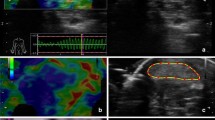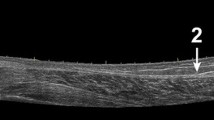Summary
267 normal controls of different ages underwent achilles tendon thickness measurements by ultrasonography (US) for reference. 96 recruits and 10 young women additionally underwent magnetic resonance imaging of the achilles tendons and calves for more systematic evaluation of the factors influencing tendon thickness. Children under 10 had a tendon thickness (mean±SD) of 4.6±0.8 mm, 10–17 year-olds 6.1±0.8 mm, 18–30 year-olds 6.3±0.5 mm and over 30 year-olds 6.9±1.0 mm. Women had slightly thinner tendons than men, but the difference was statistically significant only in the oldest age group. Normal variation in shape of the tendon caused up to a 25% variation in the measured thickness values. In the large sample of recruits a statistically significant correlation was found between the tendon thickness and body height. Differences in population height could account for the measured differences in normal achilles tendon thickness found in studies on Japanese subjects compared with studies on European and American subjects.
Résumé
L'épaisseur du tendon calcanéen de 267 sujets normaux d'âges différents a été mesurée par échographie. 96 recrues et 10 jeunes femmes ont en plus subi une imagerie par résonance magnétique des tendons calcanéens et des mollets pour une évaluation plus systématique des facteurs pouvant influencer l'épaisseur du tendon. L'épaisseur du tendon était de 4,6±0,8 mm chez les enfants de moins de 10 ans, de 6,1±0,8 mm chez les adolescents de 10 à 17 ans, de 6,3±0,5 mm chez les adultes de 18 à 30 ans, et de 6,9±1,0 mm chez ceux de plus de 30 ans. Les femmes avaient des tendons légèrement plus fins que les hommes, mais la différence n'etait pas statistiquement significative, sauf dans la tranche d'âge la plus élevée. Les variations normales de forme du tendon provoquaient des variations de plus de 25 % des valeurs de l'épaisseur tendineuse. Dans la population des recrues, une corrélation statistiquement significative existait entre l'épaisseur tendineuse et la taille. Des différences de taille dans la population étudiée peuvent expliquer les différences observées lors des mesures d'épaisseur de tendon calcanéen effectuées sur des sujets japonais d'une part, des sujets européens et américains d'autre part.
Similar content being viewed by others
References
Altman DG (1993) Practical statistics for medical research, 1st edn. Chapman & Hall, London, p 401
Bude RO, Adler RS, Basset DR, Ikeda DM, Rubin JM (1993) Heterozygous familial hypercholesterolemia: detection of xanthomas in the achilles tendon with US. Radiology 188: 567–571
Crouse JR, Grundy SM, Ahrens ER (1972) Cholesterol distribution in bulk tissues of man: variation with age. J Clin Invest 51: 1292–1296
Ebeling T, Farin P, Pyörälä K (1992) Ultrasonography in the detection of achilles tendon xanthomata in heterozygous familial hypercholesterolemia. Atherosclerosis 97: 217–228
Fornage BD (1986) Achilles tendon: US examination. Radiology 159: 759–764
van Holsbeeck M, Introcaso JH (1991) Musculoskeletal ultrasound. Mosby, St Louis, pp 57–61
Jadoul M, Malghem J, Vande Berg B, van Ypersele de Strihou (1993) Ultrasonic detection of thickened joint capsules and tendons as marker of dialysis-related amyloidosis: a cross-sectional and longitudinal study. Nephrol Dial Transplant 8: 1104–1109
Kainberger F, Seidl G, Traindl O, Tratting S, Breitenseher M, Schneider B, Gisinger C (1993) Ultrasonography of the achilles tendon in hypercholesterolemia. Acta Radiol 34: 408–412
Kallinen M, Suominen H (1994) Ultrasonographic measurements of the Achilles tendon in elderly athletes and sedentary men. Acta Radiol 35: 560–563
Koivunen-Niemelä T, Alanen A, Viikari J (1993) Sonography of the achilles tendon in hypercholesterolemia. J Intern Med 234: 401–405
Liem MSL, Gevers Leuven JA, Bloem JL, Schipper J (1992) Magnetic resonance imaging of achilles tendon xanthomas in familial hypercholesterolemia. Skeletal Radiol 21: 453–457
Mathieson JR, Connel DG, Cooperberg PL, Robertson Lloyd-Smith D (1988) Sonography of the achilles tendon and adjacent bursae. AJR 151: 127–131
Steinmetz A, Schmitt W, Schuler P, Kleinsorge F, Schneider J, Kaffranik H (1988) Ultrasonography of achilles tendons in primary hypercholesterolemia. Comparison with computed tomography. Atherosclerosis 74: 231–239
Yuzava K, Yamakawa K, Tohno E, et al (1989) An ultrasonic method for detection of achilles tendon xanthomas in familial hypercholesterolemia. Atherosclerosis 15: 211–219
Author information
Authors and Affiliations
Rights and permissions
About this article
Cite this article
Koivunen-Niemelä, T., Parkkola, K. Anatomy of the Achilles tendon (tendo calcaneus) with respect to tendon thickness measurements. Surg Radiol Anat 17, 263–268 (1995). https://doi.org/10.1007/BF01795061
Received:
Accepted:
Issue Date:
DOI: https://doi.org/10.1007/BF01795061




